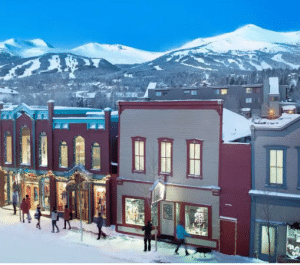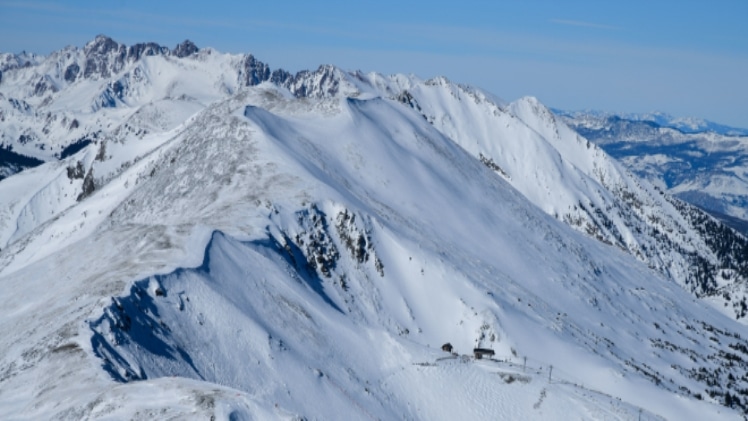Breckenridge as a Ski Resort
The inception of Breckenridge Ski Resort in December 1961 marked a pivotal moment for the town, introducing a new era under the guidance of Bill Rounds from the Rounds and Porter Lumber Company. This initiative was part of a broader push to enhance Colorado’s ski industry, supported enthusiastically by the U.S. Forest Service. Originally, the resort featured just a single double chairlift, a modest ski tow, and a basic base lodge.
The establishment of the ski resort played a crucial role in rejuvenating Breckenridge’s economy, making it a magnet for ski enthusiasts globally due to its superb snow quality, expansive skiing terrain, and the quaint allure of the historic mining town.
Through the decades, Breckenridge Ski Resort has experienced considerable growth. Today, it proudly encompasses five peaks—Peaks 6 through 10—catering to all levels of skiing proficiency, from novices to experts seeking adrenaline in the backcountry. Known for its elevated alpine bowls, abundant snow, and impeccably maintained trails, the resort has cemented its reputation as a top destination in the skiing world.
The journey to Breckendridge begins at your point of arrival. If you’re arriving at Denver Airport, you’ll need a shuttle from Denver to Breckenridge, which is at least a 2-hour journey. If you choose a private shuttle service, you can get to your hotel or accommodation without any hassle. Your travel can be with the highest comfort once you sit in the cabin of the transfer SUV and enjoy the marvellous scenery outside the window.
Breckenridge has also become a year-round destination, with summer activities such as hiking, mountain biking, and festivals that attract visitors outside the winter season. The town has maintained much of its historic architecture, with many buildings now housing shops, restaurants, and galleries that reflect its rich heritage.
The transformation into a ski resort has not only boosted the local economy but also preserved the town’s historical legacy. Breckenridge is a prime example of how tourism can be leveraged to support historical preservation and economic sustainability.
Today, Breckenridge remains one of the most popular ski destinations in North America, renowned for its blend of outdoor adventure and historical charm, drawing visitors year-round to experience its unique offerings.
History of Breckenridge
Breckenridge, located in the heart of the Colorado Rockies, has a rich history that predates its fame as a ski resort. Originally inhabited by the Ute Indians, the area was noted for its stunning natural beauty and abundant resources. The town of Breckenridge was founded in 1859 during the Pike’s Peak Gold Rush. Named after John C. Breckenridge, Vice President under James Buchanan and a U.S. Senator, the town quickly became a thriving hub for prospectors seeking their fortunes in gold.
As a mining town, Breckenridge flourished in the late 19th century, with a population that swelled as gold, silver, and lead were extracted from the surrounding mountains. Despite the harsh conditions, the town boasted a vibrant community, complete with saloons, a school, and a newspaper.
The decline of mining in the early 20th century led to a significant reduction in population and economic activity in Breckenridge. The once bustling streets quieted, and it became a quiet, somewhat forgotten part of Colorado’s mountain landscape. However, its charm and picturesque setting remained, setting the stage for its rebirth as a recreational destination.
What is located near Breckendridge?
Breckenridge serves as a perfect hub for exploring the scenic grandeur of Summit County and beyond, offering a blend of attractions that rival other renowned resort destinations in their allure and diversity.

Nearby Frisco, just a stone’s throw from Breckenridge, offers an idyllic mountain town experience with its quaint shops and eateries, much like a smaller cousin to Aspen’s bustling streets. The Frisco Adventure Park adds a layer of outdoor thrill with its tubing hills and Nordic trails, reminiscent of Park City’s family-friendly offerings but with a unique local twist.
Dillon and Silverthorne, nestled close together like twin jewels on the shores of the expansive Lake Dillon, evoke the tranquility of Lake Tahoe. Here, the water is a playground for boats and paddleboards during the day, while the evenings might bring melodies from the Dillon Amphitheater, echoing the vibrant summer concert scenes found in Vail.
Speaking of Vail, just about an hour’s drive from Breckenridge, it stands as a beacon of upscale ski and lifestyle culture, yet Breckenridge matches its charm with a more laid-back vibe and equally impressive slopes. Keystone Resort, a mere 20 minutes away, complements this with night skiing options and year-round mountain activities that bring to mind the round-the-clock excitement of Whistler.
Further afield, the rugged landscapes of Arapahoe Basin and Loveland Ski Area provide more than just skiing; they are havens for the winter sport aficionados, their extended seasons and family-friendly atmospheres providing a less crowded alternative to the often-bustling scenes at larger resorts like Colorado’s own Copper Mountain.
For those drawn to the heights, Leadville’s rich mining history and high-altitude charm offer a glimpse into Colorado’s vibrant past, similar to the historical depth found in towns like Telluride, yet uniquely accessible in its rustic authenticity. Meanwhile, Mount Evans and Independence Pass offer panoramic vistas and wildlife encounters that rival the majesty of drives through California’s Sierra Nevada.
Not to be overlooked, the majestic Rocky Mountain National Park, with trails and views that compete with those of Yellowstone, lies just a couple of hours away, promising adventures through landscapes where every turn mirrors a scene from a nature documentary.
Every destination surrounding Breckenridge stitches together a rich mosaic of outdoor adventure and cultural depth, establishing the area as a prime spot for adventurers and nature enthusiasts. It mirrors the vibrant allure of the European Alps, yet retains a unique American character with its pristine natural landscapes.
Cultural life of Breckendridge
Breckenridge, Colorado, is more than just a ski paradise and a haven for nature lovers; it also buzzes with a dynamic cultural atmosphere that enhances its charming, historic mountain town essence. At the heart of Breckenridge’s cultural vibrancy is the Breckenridge Creative Arts District, which teems with artistic energy throughout the year. This district enriches the community with a plethora of galleries and workshops offering a range of crafts from pottery and painting to glassblowing and textile arts, making the arts accessible and engaging for both locals and visitors. These venues also serve as platforms for diverse artistic performances and installations, displaying a wide spectrum of creativity.
Further embracing its heritage, Breckenridge commemorates its past as a thriving gold mining town through meticulously maintained museums and historical sites managed by the Breckenridge Heritage Alliance. Notable among these are the Barney Ford House Museum, which chronicles the inspiring story of Barney Ford, an escaped slave who rose to become a successful entrepreneur and a civil rights pioneer in Colorado. Another key historical site, the Edwin Carter Museum, delves into the region’s natural environment and honors Edwin Carter, an early conservationist and naturalist whose work left a lasting impact on local wildlife preservation.
Through such rich and varied cultural expressions, Breckenridge not only preserves its historical character but also fosters an enriching environment that endears it to visitors and residents alike throughout the year. The town’s dedication to celebrating arts, history, and community through such diverse channels creates a vibrant, cultural mosaic that enriches everyone who experiences it.


